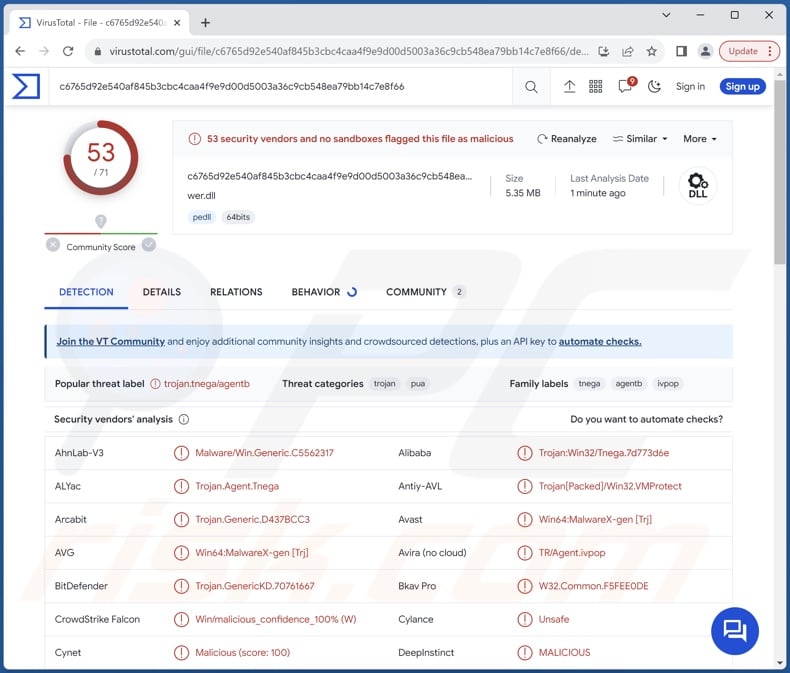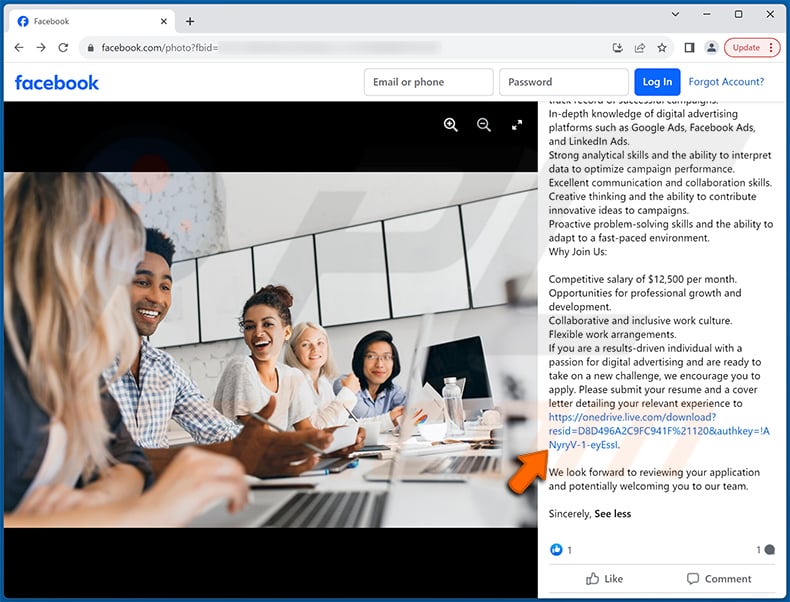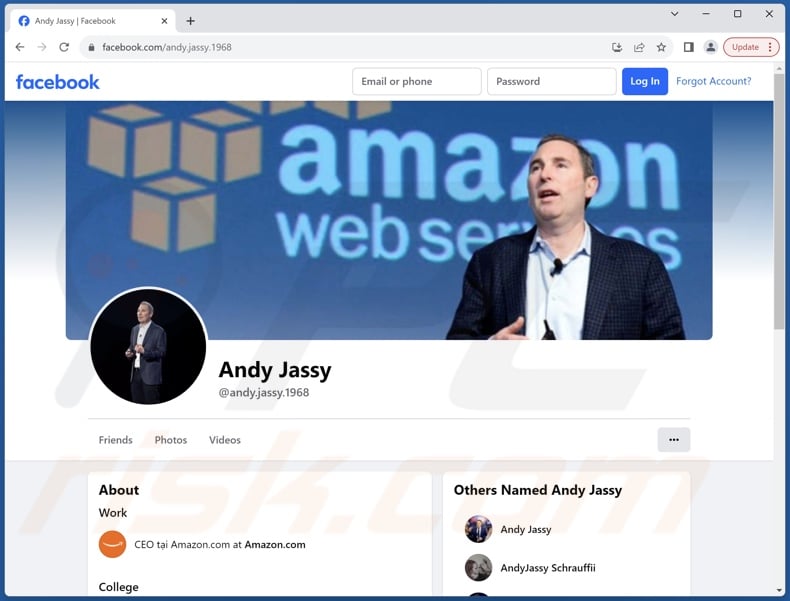How to remove Ov3r_Stealer malware from the operating system
TrojanAlso Known As: Ov3r_Stealer virus
Get free scan and check if your device is infected.
Remove it nowTo use full-featured product, you have to purchase a license for Combo Cleaner. Seven days free trial available. Combo Cleaner is owned and operated by RCS LT, the parent company of PCRisk.com.
What kind of malware is Ov3r_Stealer?
Ov3r_Stealer is the name of an information-stealing malware. This program primarily targets log-in credentials and cryptocurrency wallets. There is some evidence suggesting that Ov3r_Stealer might have been based on the Phemedrone data-stealer. Ov3r_Stealer has been observed being spread via Facebook advertising centered on job offers.

Ov3r_Stealer malware overview
Ov3r_Stealer infiltrates systems following a multi-stage infection chain (described below). After the malware establishes persistence, it begins collecting relevant device data (e.g., hardware and system details, geolocation, etc.). The stealer uses Telegram for its C&C (Command and Control).
Ov3r_Stealer seeks to acquire the log-in credentials and other information related to cryptocurrency wallets. The program also aims to exfiltrate Microsoft Word and Excel, as well as plain text files. It also collects data associated with messengers and FTP (File Transfer Protocol) clients.
By far the most extensive target list of Ov3r_Stealer concerns browser extensions, it includes dozes of password managers and cryptocurrency-related add-ons (full list). Information stored on browsers is of interest to this malware as well. It can extract and exfiltrate Internet cookies, auto-fills, passwords, and credit card details. The stolen content is then sent to the attackers' C&C channel.
It is pertinent to mention that malware developers commonly improve upon their software and techniques. Therefore, potential future variants of Ov3r_Stealer could boast additional/different capabilities and features.
In summary, the presence of software like Ov3r_Stealer on devices may lead to severe privacy issues, financial losses, and identity theft.
| Name | Ov3r_Stealer virus |
| Threat Type | Trojan, stealer, password-stealing virus, banking malware, spyware. |
| Detection Names | Avast (Win64:MalwareX-gen [Trj]), Combo Cleaner (Trojan.GenericKD.70761667), ESET-NOD32 (Win64/Agent.DFY), Kaspersky (Trojan.Win64.Agentb.kxjc), Microsoft (Trojan:Win32/Tnega!MSR), Full List Of Detections (VirusTotal) |
| Symptoms | Trojans are designed to stealthily infiltrate the victim's computer and remain silent, and thus no particular symptoms are clearly visible on an infected machine. |
| Distribution methods | Infected email attachments, malicious online advertisements, social engineering, software 'cracks'. |
| Damage | Stolen passwords and banking information, identity theft, the victim's computer added to a botnet. |
| Malware Removal (Windows) |
To eliminate possible malware infections, scan your computer with legitimate antivirus software. Our security researchers recommend using Combo Cleaner. Download Combo CleanerTo use full-featured product, you have to purchase a license for Combo Cleaner. 7 days free trial available. Combo Cleaner is owned and operated by RCS LT, the parent company of PCRisk.com. |
Similar malware examples
We have researched countless malware samples; Nightingale, Rage, and GoStealer are merely a couple of our newest articles on stealers. Malicious programs that target data may seek a broad range of information or only specific details. Data stealing and tracking are standard features for various types of malware.
It must be stressed that regardless of how a piece of malicious software operates – its presence on a system threatens device and user safety. Therefore, all threats must be removed immediately upon detection.
How did Ov3r_Stealer infiltrate my computer?
The cybersecurity community has discovered many pseudonyms used by the threat actors linked to Ov3r_Stealer. This stealer has likewise been discussed on multiple hacker-frequented platforms. At the time of writing, the exclusivity of this malware is not definitive.
As mentioned in the introduction, the known origins of Ov3r_Stealer's infections are job-offer-related advertisements on the Facebook social media platform. Both the initial and later stages of infection have variations.
The deceptive ad could lead victims to open a Discord content delivery URL – thus triggering the infection chain. Alternatively, the Facebook adverts could promote an infectious PDF document – this chain relies on several malicious URLs and a fake DocuSign file.
The later stages may involve a supposed Windows Control Panel binary hiding a PowerShell script that, upon execution, downloads Ov3r_Stealer as three files from GitHub. However, these files could wind up on victims' systems through a different process.
The chain can rely on several loader programs, which in turn utilize HTML smuggling (infiltration of malicious code through HTML files), SVG smuggling (content infiltration through JavaScript-embedded SVG files), and LNK (Windows shortcut) files that disguise virulent executables.
These loader stages infiltrate the three files: "WerFaultSecure.exe" (a legitimate Windows executable), "Wer.dll", and "Secure.pdf" (filenames may vary). The DLL side-loading technique – wherein the Windows DLL search order mechanism executes the malware payload by leveraging a legitimate application – is utilized to finalize the infection.
Therefore, instead of "WerFaultSecure.exe" – "Wer.dll" is executed. While "Secure.pdf" contains malicious code for "Wer.dll" to load. This stage culminates in Ov3r_Stealer's installation. It is noteworthy that other methods could be used to proliferate and infiltrate this stealer into systems.
Generally, cyber criminals use phishing and social engineering to spread malware. Malicious software is typically disguised as or bundled with ordinary content. Virulent files come in various formats, e.g., executables (.exe, .run, etc.), archives (ZIP, RAR, etc.), documents (Microsoft Office, Microsoft OneNote, PDF, etc.), JavaScript, and so forth.
The most widely used proliferation techniques include: drive-by (stealthy/deceptive) downloads, malicious attachments/links in spam (e.g., emails, DMs/PMs, social media posts, etc.), malvertising, online scams, dubious download channels (e.g., freeware and third-party websites, Peer-to-Peer sharing networks, etc.), pirated programs/media, illegal software activation tools ("cracks"), and fake updates.
Furthermore, some malicious programs can self-spread via local networks and removable storage devices (e.g., external hard drives, USB flash drives, etc.).
How to avoid installation of malware?
We strongly recommend exercising caution while browsing, as fraudulent and dangerous online content typically appears genuine and innocuous. Be careful with incoming emails/messages, and do not open attachments or links found in dubious mail since they can be malicious.
Additionally, download only from official and verified sources. Another recommendation is to activate and update software using functions/tools provided by legitimate developers, as those obtained from third-parties may contain malware.
We must emphasize that having a reputable anti-virus installed and kept updated is essential to device integrity and user safety. Security programs must be used to perform regular system scans and to remove detected threats. If you believe that your computer is already infected, we recommend running a scan with Combo Cleaner Antivirus for Windows to automatically eliminate infiltrated malware.
Software targeted by Ov3r_Stealer malware;
Messaging software:
Discord
FTP clients:
FileZilla
Authentication and password management browser extensions:
Aegis Authenticator, Authy, Avira Password Manager, Bitwarden, Browserpass, CommonKey, Dashlane, Duo Mobile, EOS Authenticator, FreeOTP, Google Authenticator, KeePass, KeePassXC, Keeper, LastPass Authenticator, Microsoft Authenticator, Myki, NordPass, Norton Password Manager, OTP Auth, RoboForm, Secure Password, Splikity, Trezor Password Manager, Zoho Vault.
Cryptowallets and cryptocurrency-related browser extensions:
Airbitz, Atomic, BinanceChain, Bitbox, Bread (BRD), Byone, Bytecoin, Coin98, Coinomi, Copay, Edge, Electrum, Exodus, GreenAddress, Guarda, ICONex, iWallet, Jaxx Liberty, Keplr, KHC, Ledger, MetaMask, Metawallet, MEW CX, Mycelium, NeoLine, OneKey, Samourai, Sollet, Terra Station, TezBox, Trezor, TronLink, Trust, Wombat, YubiKey
Screenshot of a fake Facebook ad used to proliferate Ov3r_Stealer:

Screenshot of the fake Facebook account used to post the malicious ad:

Instant automatic malware removal:
Manual threat removal might be a lengthy and complicated process that requires advanced IT skills. Combo Cleaner is a professional automatic malware removal tool that is recommended to get rid of malware. Download it by clicking the button below:
DOWNLOAD Combo CleanerBy downloading any software listed on this website you agree to our Privacy Policy and Terms of Use. To use full-featured product, you have to purchase a license for Combo Cleaner. 7 days free trial available. Combo Cleaner is owned and operated by RCS LT, the parent company of PCRisk.com.
Quick menu:
- What is Ov3r_Stealer?
- STEP 1. Manual removal of Ov3r_Stealer malware.
- STEP 2. Check if your computer is clean.
How to remove malware manually?
Manual malware removal is a complicated task - usually it is best to allow antivirus or anti-malware programs to do this automatically. To remove this malware we recommend using Combo Cleaner Antivirus for Windows.
If you wish to remove malware manually, the first step is to identify the name of the malware that you are trying to remove. Here is an example of a suspicious program running on a user's computer:

If you checked the list of programs running on your computer, for example, using task manager, and identified a program that looks suspicious, you should continue with these steps:
 Download a program called Autoruns. This program shows auto-start applications, Registry, and file system locations:
Download a program called Autoruns. This program shows auto-start applications, Registry, and file system locations:

 Restart your computer into Safe Mode:
Restart your computer into Safe Mode:
Windows XP and Windows 7 users: Start your computer in Safe Mode. Click Start, click Shut Down, click Restart, click OK. During your computer start process, press the F8 key on your keyboard multiple times until you see the Windows Advanced Option menu, and then select Safe Mode with Networking from the list.

Video showing how to start Windows 7 in "Safe Mode with Networking":
Windows 8 users: Start Windows 8 is Safe Mode with Networking - Go to Windows 8 Start Screen, type Advanced, in the search results select Settings. Click Advanced startup options, in the opened "General PC Settings" window, select Advanced startup.
Click the "Restart now" button. Your computer will now restart into the "Advanced Startup options menu". Click the "Troubleshoot" button, and then click the "Advanced options" button. In the advanced option screen, click "Startup settings".
Click the "Restart" button. Your PC will restart into the Startup Settings screen. Press F5 to boot in Safe Mode with Networking.

Video showing how to start Windows 8 in "Safe Mode with Networking":
Windows 10 users: Click the Windows logo and select the Power icon. In the opened menu click "Restart" while holding "Shift" button on your keyboard. In the "choose an option" window click on the "Troubleshoot", next select "Advanced options".
In the advanced options menu select "Startup Settings" and click on the "Restart" button. In the following window you should click the "F5" button on your keyboard. This will restart your operating system in safe mode with networking.

Video showing how to start Windows 10 in "Safe Mode with Networking":
 Extract the downloaded archive and run the Autoruns.exe file.
Extract the downloaded archive and run the Autoruns.exe file.

 In the Autoruns application, click "Options" at the top and uncheck "Hide Empty Locations" and "Hide Windows Entries" options. After this procedure, click the "Refresh" icon.
In the Autoruns application, click "Options" at the top and uncheck "Hide Empty Locations" and "Hide Windows Entries" options. After this procedure, click the "Refresh" icon.

 Check the list provided by the Autoruns application and locate the malware file that you want to eliminate.
Check the list provided by the Autoruns application and locate the malware file that you want to eliminate.
You should write down its full path and name. Note that some malware hides process names under legitimate Windows process names. At this stage, it is very important to avoid removing system files. After you locate the suspicious program you wish to remove, right click your mouse over its name and choose "Delete".

After removing the malware through the Autoruns application (this ensures that the malware will not run automatically on the next system startup), you should search for the malware name on your computer. Be sure to enable hidden files and folders before proceeding. If you find the filename of the malware, be sure to remove it.

Reboot your computer in normal mode. Following these steps should remove any malware from your computer. Note that manual threat removal requires advanced computer skills. If you do not have these skills, leave malware removal to antivirus and anti-malware programs.
These steps might not work with advanced malware infections. As always it is best to prevent infection than try to remove malware later. To keep your computer safe, install the latest operating system updates and use antivirus software. To be sure your computer is free of malware infections, we recommend scanning it with Combo Cleaner Antivirus for Windows.
Frequently Asked Questions (FAQ)
My computer is infected with Ov3r_Stealer malware, should I format my storage device to get rid of it?
It is rarely necessary to format devices in order to remove malware.
What are the biggest issues that Ov3r_Stealer malware can cause?
The dangers posed by an infection depend on the malware's functionalities and the cyber criminals' goals. Ov3r_Stealer is a data-stealing program that predominantly targets log-in credentials and cryptocurrency wallets. Typically, such infections can result in serious privacy issues, financial losses, and even identity theft.
What is the purpose of Ov3r_Stealer malware?
Malware is primarily used for profit. However, attackers may also seek to amuse themselves, carry out personal vendettas, disrupt processes (e.g., sites, services, companies, etc.), engage in hacktivism, and launch politically/geopolitically motivated attacks.
How did Ov3r_Stealer malware infiltrate my computer?
Ov3r_Stealer has been noted being spread via malicious job-related advertisements on Facebook. However, other techniques may also be in use to proliferate this stealer.
Aside from malvertising, malware is commonly distributed through drive-by downloads, spam (e.g., emails, PMs/DMs, social media posts, etc.), online scams, untrustworthy download channels (e.g., freeware and free file-hosting websites, P2P sharing networks, etc.), illegal software activation tools ("class"), and fake updates. Some malicious programs can even self-spread via local networks and removable storage devices.
Will Combo Cleaner protect me from malware?
Yes, Combo Cleaner can detect and remove practically all known malware infections. Note that performing a complete system scan is crucial since high-end malicious software typically hides deep within systems.
Share:

Tomas Meskauskas
Expert security researcher, professional malware analyst
I am passionate about computer security and technology. I have an experience of over 10 years working in various companies related to computer technical issue solving and Internet security. I have been working as an author and editor for pcrisk.com since 2010. Follow me on Twitter and LinkedIn to stay informed about the latest online security threats.
PCrisk security portal is brought by a company RCS LT.
Joined forces of security researchers help educate computer users about the latest online security threats. More information about the company RCS LT.
Our malware removal guides are free. However, if you want to support us you can send us a donation.
DonatePCrisk security portal is brought by a company RCS LT.
Joined forces of security researchers help educate computer users about the latest online security threats. More information about the company RCS LT.
Our malware removal guides are free. However, if you want to support us you can send us a donation.
Donate
▼ Show Discussion